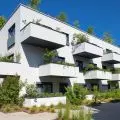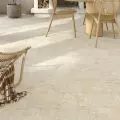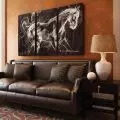Archaeologists know very well that most treasures are found underground, and the same is true of unique treasures of technology, for which a unique place has been created in Krakow's Kazimierz, although from street level it is completely inconspicuous.
The historic streetcar depot on St. Lawrence Street in Krakow still hides many secrets. The renovation of the Museum of Engineering and Technology building has finally solved some of the problems that had been an obstacle to visiting the museum.
Part of Krakow's historic streetcar depot on St. Lawrence Street still hides many secrets
© Museum of Engineering and Technology
How to create new functions in a place marked by numerous resolutions and historic preservation provisions? How did the sizable space of the former depot change? To what extent was it creation, and to what extent conservation? We discuss this with one of the designers of the depot's revaluation, Magdalena Matejko (PKZ Arkona).
Wiktor Bochenek: Let's start with the beginnings of the depot's revaluation process. What was most important at the start of the design process?
Magdalena Matejko: The starting point was the new functional program that the Museum of Technology expected - the communication connection of all the halls and buildings into one whole. The previous way of functioning of the museum was inconvenient for visitors: in one building there was a reception desk, in another place you bought a ticket, in order to visit an exhibition, you had to enter one hall, go outside, go to the next one... The new idea was based on connecting these facilities, making it possible to visit without going outside.
The second thing was to expand the museum with new exhibition spaces and bring out the historic qualities of the building.
The biggest problem during the tour was the lack of connections between the buildings
© Museum of Engineering and Technology
Wiktor: Towhat extent was this a creation job and to what extent a conservation job?
Magdalena: In historic buildings or ensembles, such as the depot, when embarking on a design, you have to think about what is most valuable and how to bring out those qualities. In between, there is room for creation. The most important thing is that the building is somehow unique, which can be not only preserved but also emphasized in the design.
The museum also lacked space to expand the exhibitions
© Museum of Engineering and Technology
Wiktor: What is unique about the depot?
Magdalena: In this complex, certainly the exterior layout of the building complex, which has been preserved, and the very structural elements of the existing halls, which have not been disturbed.
To protect Hall D, the largest in the depot complex, whose roof rests on internal iron pillars, we decided not to dismantle it, but to make a basement while preserving the structure. First we used temporary supports, then target supports - the whole technology was quite complicated, but the result was the construction of a basement floor under the surface of the entire hall, without having to dismantle it.
In the building you will find preserved elements from the time when streetcars were repaired here
© Museum of Engineering and Technology
Wiktor: This made it possible to enlarge the whole by what area?
Magdalena: As far as Hall D is concerned, we managed to double this area. In the newly created basement spaces there was also room for technical rooms that serve the building.
In Hall D we exposed the relic of the tunnel leading to the slag tank. This was a section of the building that was underground, was completely unexposed, and has now been shown and available to the public.
The second such element is that a relic of the substructure has been left and exposed, which can be looked at by descending the stairs from the first floor to the new basement level. Originally this hall was used for repairing streetcars. In this part there were channels for overhaul and repair. A fragment of this relic has been preserved here. It was never exposed.
Planners wondered how to design the entire building so that it interfered as little as possible with the existing tissue
© Museum of Engineering and Technology
Wiktor: To what extent were these technical elements exposed? What did this entail from an architectural perspective?
Magdalena: We wanted to expose them as much as possible. The tour path starts next to the tanks. With a little imagination, you can picture what the place looked like a hundred years ago.
Wiktor: It didn't involve more problems when the project was approved with the conservationist?
Magdalena: Solutions proposing the preservation and exposure of historic elements are usually evaluated positively by the conservator's office. In this case, we met with full approval. If we wanted to do away with it all, to remodel it heavily, we would certainly face opposition. Such treatments are also valuable for the site itself.
Wiktor: Particularly at the Museum of Engineering and Technology. You mentioned expanding the space, but what about communication inside the museum?
Magdalena: We had to think well about the functionality of the facility. Together with the museum, we worked out an idea for the functioning of the whole. We determined the entrance zones, the initial directions of the tour, which were modified in the process of building equipment, but already in the construction phase we had to anticipate which way visitors would pass and where they would encounter stairs and elevators.
We thought about how to design the entire facility to interfere as little as possible with the existing fabric. That's why some of the connecting passageways between the buildings are underground, and those above ground are glazed so that they don't compete with the external architecture.
It was important to make basements, which allowed doubling the area of the hall D
© Museum of Engineering and Technology
Wiktor: Which of the monuments on display in the exhibition doyou like best?
Magdalena: In terms of equipment, the exhibition is very interesting. It is difficult to choose one exhibit, because it is an extremely rich exhibition and contains a great deal of knowledge and information. I really like the space with photos of old railroad station halls and waiting rooms, it has a unique atmosphere. The collection of beautiful vintage vehicles and streetcars is also great, of course.
Wiktor: What was the most difficult part of the whole process?
Magdalena: I think the most difficult part was making the sub-basements. First of all, we are in a historic fabric. Secondly, we are close to the river and the groundwater level is quite high here. It was necessary to protect these new spaces from the pressure of the water that is here. This process of shoring up the pillars was a major design and implementation challenge. In addition, the walls of the buildings are within the boundaries of the plots.
Wiktor: Andwhat was the most satisfying thing about this revaluation?
Magdalena: That it is so nice [laughs]. A pleasant, functional space was created, which was put to great use by the authors of the exhibition. The process was very long, because always in investments in existing historic fabric, unforeseen problems arise during implementation. What is satisfying is that the museum is up and running and the exhibition can be visited.
Victor: Thank you for the interview.

































